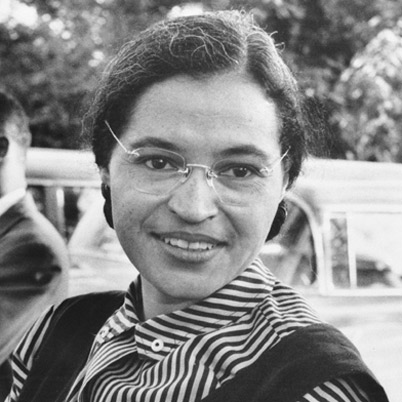The bravery of Rosa Parks is legendary. The Alabama seamstress and NAACP activist refused to move to the back of the bus in 1955. Her arrest sparked the successful Montgomery Bus Boycott, a defining moment of the modern day civil rights movement. By the time the year-long boycott ended, Parks had become an American icon and the Rev. Dr. Martin Luther King Jr., soon emerged as the leader of the national movement for racial equality.
Women Leaders Made Amazing Contributions
However, most people don’t know that an African American woman named Ella Baker helped lay the groundwork for the boycott years earlier when she worked with Rosa Parks and others to develop the NAACP in Alabama. Even fewer people are aware that the person who originally proposed the Montgomery Bus Boycott and stirred community support was another black woman named Jo Ann Gibson Robinson, a local college professor and community activist.
In fact, today when most people think about the architects, organizers and strategists of the civil rights movement—from its infancy through its zenith—the names that generally come to mind first are those of the charismatic and visionary African American male leaders who were the major public voices of the era: Dr. King, the Rev. Andrew Young, Julian Bond, the Rev. Jesse L. Jackson Sr., John Lewis, Roy Wilkins, James Foreman and the list goes on.
To be sure, King was a prominent leader and all these men were righteous warriors who put their lives on the line in the struggle for social change and inspired thousands to support the civil rights movement. But they did not act alone. Scores of African American women led from behind the scenes and on the frontlines throughout the civil rights era.
Some of these women activists of the 20th century could even be called prototypical transformational leaders whose lives continue to provide lessons for us in the 21st century. They were courageous change agents.
Ella Baker: SCLC & Grassroots Organizer
It is no coincidence that when a group of ministers led by Dr. King established the Southern Christian Leadership Conference (SCLC) in 1957, they hired Ella Baker, the veteran NAACP activist, to single-handedly establish the infrastructure of the fledgling organization and oversee its day-to-day operation. She then successfully launched the organization’s first initiative, the SCLC’s Crusade for Citizenship. But Baker believed that the grassroots masses should determine the direction of the civil rights movement instead of a handful of charismatic ministers. And so within SCLC, she worked to empower other women, men and children not only to protest, demonstrate, and vote, but also to become leaders themselves.
Baker rallied students from throughout the South and North in the summer of 1960 and spurred them to create the Student Non-Violent Coordinating Committee (SNCC).
Ruby Doris Smith: Leading Student Activism
Young people like Ruby Doris Smith, a Spelman College student, embraced Ella Baker’s collective leadership approach to social change and became a transformational leader herself. Smith started as executive secretary of the Atlanta Student Movement in 1960. The next year, she became involved in SNCC and quickly became the first full-time southern campus coordinator for that organization. Known for her fearlessness and resolve, Ruby Doris Smith joined the Freedom Riders to push for the desegregation of interstate buses throughout the South. She was the one who established SNCC’s “jail, no bail policy.” In 1963 Smith was appointed SNCC’s administrative secretary and a full-time member of the central office staff. Three years later, she succeeded James Foreman as national executive secretary of SNCC, planning and overseeing the grassroots initiatives in the South and North. She was the only woman to ever serve in that capacity. The infrastructure and systems that Ruby Doris Smith established during her tenure as a leader of SNCC helped ensure the success of mass voter registration drives and demonstrations against segregation.
Fannie Lou Hamer: Leading the Fight for Recognition
Fannie Lou Hamer, another transformational leader of the movement, grew up picking cotton on a Mississippi plantation and continued to work there as an adult until she decided she was “sick and tired of being sick and tired” and became an activist. She helped SNCC organize the Mississippi Freedom Summer in 1964 and advised black and white students who came to the South to assist in voter registration.
Hamer went on to become a leader of the Mississippi Freedom Democratic Party and traveled to the 1964 Democratic Convention to challenge the all white delegation from her state. Eventually, the Democratic Party established a policy for the 1968 convention mandating states to send delegations representing all their citizens. That change came about, in part, as a result of Hamer’s public testimony about the abuses she and others suffered when they tried to register to vote.
Septima Clark & Dorothy Cotton: Leading Community Activism
Septima Clark and Dorothy Cotton were two educators who taught, inspired and empowered grassroots men and women to claim their voting rights. Clark developed and taught literacy and citizenship workshops at the Highlander Folk School in Tennessee, a major training ground for black and white activists in the struggle for social change. As the Education Director for SCLC, Cotton was the highest-ranking woman in the organization. In the early 1960s both women, along with Rev. King’s lieutenant, Rev. Andrew Young, established the SCLC Citizenship Education Program (CEP). Through this program, they prepared black adults for the literacy tests they would be required to take before being allowed to register to vote. They also trained grassroots African Americans to establish citizenship schools and lead protests in their own communities.
So Many Unsung Heroes
The activists mentioned here are just a few of the transformational women leaders of the civil rights movement. Most of these women made their contributions without fanfare, even downplaying the importance of their personal leadership. They focused instead on ensuring the success of the collective efforts they organized and directed: Initiatives devoted to claiming black voting rights, improving African Americans’ quality of life and obtaining equal access to education, jobs and public facilities. All of them kept the movement going in spite of the complexity, ambiguity, uncertainty and constant danger that always surrounded them.
And eventually because of their stealth, dedicated leadership style, a nation was transformed.









